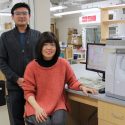Geochemical technique yields biomedical promise
Adapting a technique used routinely by geologists to measure the chemical composition of rocks, scientists may have found a better way to sample bone calcium balance in humans.
In a report to scientists here today (Dec. 17, 2004) at the fall meeting of the American Geophysical Union, UW paleontologist Joseph Skulan described the application of a standard geochemical technique to measure calcium isotopes in human urine.
The development may have implications for early diagnosis of osteoporosis and, more immediately, for testing drugs to treat the bone-wasting disease and other serious calcium-related disorders.
In humans and other vertebrates, calcium is primarily locked up in the skeleton and confers strength to bone. But as the body forms new bone and destroys old bone, calcium migrates in different forms between bones and blood and other biological products such as urine.
By measuring isotope concentrations in things like rocks, or urine, scientists can learn how a rock was formed or, now, how calcium is being processed in the body. The latter measure can help scientists or clinicians get a snapshot of the body processing the mineral calcium, an essential element for bone formation and health.
“There are real problems with measuring short-term changes in bone-mineral balance in the human body,” Skulan says. “What we are doing is taking a technique typically used to measure differences in the isotopic composition of sediments and rocks and applying it to a biological system. This is one of the very few times that’s ever been done.”
The redirected technique is high-precision mass spectrometry, a mainstay of modern geochemistry that is used to measure the mass of atoms of chemical elements and the relative abundance of their isotopes.
Isotopes are variants of chemical elements and different species of the same element have different masses.
“Accurate measurement of changes in bone calcium balance is critical to understanding how calcium metabolism responds to physiological and environmental changes and, more specifically, to diagnosing and evaluating the effectiveness of treatments for osteoporosis and other serious calcium-related disorders,” Skulan explains.
Skulan and his colleagues were able to assess the potential of mass spectrometry as a biomedical technique through analysis of urine samples from a previous NASA study in which human subjects were confined to strict bed rest for 17 weeks. It is well-known that people confined to bed for long periods suffer bone loss, with calcium migrating from bone to soft tissues like urine and blood.
Analyzing samples from bedridden subjects who did not exercise, Skulan’s group observed a shift in isotope composition in soft tissue that paralleled the loss in bone mass resulting from prolonged bed rest. In contrast, the group observed only a very small shift for bedridden subjects who exercised.
Intriguingly, a subset of subjects given aledronate, a drug that inhibits bone calcium loss, showed a positive calcium isotope balance, suggesting they were adding bone mass despite being bedridden for a long period.
These observations, according to Skulan, provide firm evidence that high-precision mass spectrometry applied to measuring calcium isotopes in soft tissue is a promising biomedical technique that could one day be used routinely to portray bone mineral health. Moreover, the ability to get a quick snapshot of bone mineral balance could be used to assess the efficacy of drugs to combat osteoporosis and other calcium-related disorders.
Current biomedical techniques for measuring bone calcium balance in the body, according to Skulan, are inadequate as there are two separate measures – one for bone loss and one for bone formation – that cannot be reconciled to provide a single, accurate measure of calcium balance in the body.
“The problem is there is no way to quantify those measures,” says Skulan. “To combine those measures into one metric that shows a positive or negative change is impossible. This new approach gets at the problem.”
One of the catches, Skulan explains, is that the residence time of calcium in the blood is 24 hours or less, and current techniques are not good at measuring short-term changes.
“Using isotopes, there is promise of allowing us to measure bone mineral balance on very short time scales,” says Skulan.
In addition to Skulan, team members who conducted the new study were A. Anbar of the departments of geological sciences and chemistry and biochemistry at Arizona State University, B. Thomas of the Water Resources Division of the U.S. Geological Survey, and S. Smith of NASA’s Human Adaptation and Countermeasures Office at the Johnson Space Center.
Tags: biosciences, research



